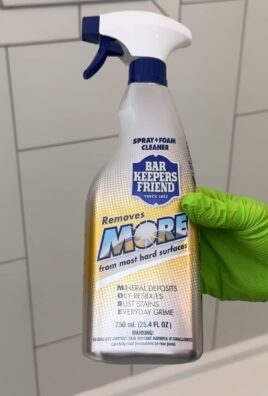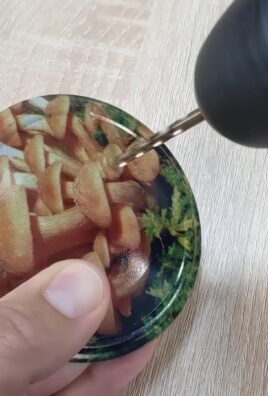DIY unclog sink projects can feel daunting, right? I get it! Staring down a sink full of murky water is nobody’s idea of a good time. But before you reach for harsh chemicals or call a pricey plumber, let’s explore some simple, effective, and surprisingly satisfying DIY solutions.
For generations, resourceful homeowners have relied on clever tricks to keep their plumbing flowing smoothly. Think about it – before the age of instant service calls, knowing how to DIY unclog sink issues was a crucial household skill. These time-tested methods are often gentler on your pipes and your wallet!
Why is this DIY knowledge so important today? Well, clogged sinks are a common household problem, and learning to tackle them yourself saves you time, money, and the potential hassle of scheduling a professional. Plus, many commercial drain cleaners contain harsh chemicals that can damage your pipes and harm the environment. By mastering these DIY techniques, you’re not just fixing a problem; you’re becoming a more self-sufficient and eco-conscious homeowner. So, let’s dive in and discover some easy ways to get your sink flowing freely again!

DIY Sink Unclogging: A Comprehensive Guide
Okay, so your sink is clogged. We’ve all been there! It’s frustrating, messy, and can really throw a wrench in your day. But before you call a plumber and shell out a bunch of money, let’s try some DIY solutions. I’m going to walk you through several methods, starting with the simplest and working our way up to the more involved. Hopefully, one of these will do the trick!
Tools You Might Need
Before we dive in, let’s gather our supplies. Having everything ready will make the process much smoother. You probably already have most of these items around the house:
* Rubber gloves (trust me, you’ll want these!)
* Bucket or basin
* Plunger (a flange plunger is best for sinks)
* Old towel or rags
* Screwdriver (Phillips and flathead)
* Adjustable wrench
* Baking soda
* White vinegar
* Boiling water
* Wire coat hanger (or a drain snake)
* Pliers
* Safety glasses (especially if using chemical drain cleaners)
* Flashlight or headlamp
Method 1: The Boiling Water Trick
This is the easiest and often the first thing I try. It works best for clogs caused by grease or soap buildup.
1. Clear the Sink: Remove any standing water from the sink. A small cup or sponge works well for this.
2. Boil Water: Heat a kettle or pot of water until it’s boiling vigorously.
3. Pour Carefully: Slowly and carefully pour the boiling water down the drain. Be cautious to avoid splashing, as boiling water can cause serious burns.
4. Wait and See: Give the water a few minutes to work its magic. If the water starts to drain, keep pouring more boiling water down the drain until it flows freely.
5. Repeat if Necessary: If the clog persists, repeat the process a couple more times. Sometimes it takes a few tries to fully dissolve the blockage.
Method 2: The Plunger Power
The plunger is a classic for a reason! It creates suction to dislodge the clog.
1. Remove Standing Water: Again, clear as much standing water from the sink as possible. Leave just enough to cover the cup of the plunger.
2. Seal the Drain: Make sure the plunger cup completely covers the drain opening. If you have an overflow drain (that little hole near the top of the sink), seal it with a wet cloth or your hand to create a better seal.
3. Plunge Vigorously: Push and pull the plunger up and down with a strong, steady motion. Maintain the seal as you plunge. You should hear gurgling sounds as the plunger works.
4. Check the Drain: After several plunges, remove the plunger and see if the water drains.
5. Repeat as Needed: If the water still isn’t draining, repeat the plunging process until the clog is cleared. It might take some elbow grease!
Method 3: Baking Soda and Vinegar Volcano
This is a natural and effective way to break down clogs. It’s also a fun science experiment!
1. Clear the Sink: Remove any standing water from the sink.
2. Pour Baking Soda: Pour about one cup of baking soda down the drain. Try to get it as far down the drain as possible.
3. Add Vinegar: Follow the baking soda with one cup of white vinegar.
4. Let it Fizz: The mixture will start to fizz and bubble. This is the chemical reaction breaking down the clog.
5. Cover the Drain: Cover the drain with a plug or rag to contain the fizzing and direct the pressure down the drain.
6. Wait 30 Minutes: Let the mixture sit for at least 30 minutes, or even longer for stubborn clogs. I sometimes let it sit overnight.
7. Flush with Boiling Water: After the waiting period, carefully pour a kettle of boiling water down the drain to flush away the loosened debris.
8. Repeat if Necessary: If the drain is still slow, repeat the baking soda and vinegar treatment.
Method 4: The Wire Coat Hanger Rescue
This method involves manually removing the clog. It’s a bit more hands-on, but often very effective.
1. Straighten the Hanger: Take a wire coat hanger and straighten it out as much as possible.
2. Create a Hook: Bend one end of the hanger into a small hook. This will be used to grab the clog.
3. Insert and Fish: Carefully insert the hooked end of the hanger down the drain. Probe around and try to snag the clog.
4. Pull Out the Gunk: Once you’ve hooked something, slowly and carefully pull the hanger back out. Be prepared for some grossness!
5. Clean the Hanger: Wipe off the hanger with a rag and dispose of the debris properly.
6. Flush with Hot Water: After removing as much debris as possible, flush the drain with hot water to clear any remaining residue.
7. Repeat if Needed: Continue fishing and flushing until the water drains freely.
Method 5: Checking and Cleaning the P-Trap
The P-trap is the curved pipe under your sink. It’s designed to trap debris and prevent sewer gases from entering your home. Unfortunately, it’s also a common place for clogs to form.
1. Prepare for a Mess: Place a bucket or basin under the P-trap to catch any water that will spill out.
2. Loosen the Slip Nuts: Locate the slip nuts that connect the P-trap to the drain pipes. Use an adjustable wrench to carefully loosen these nuts. Don’t remove them completely yet.
3. Remove the P-Trap: Once the slip nuts are loose, carefully remove the P-trap. Be prepared for water and debris to spill out.
4. Clean the P-Trap: Thoroughly clean the P-trap. Remove any debris, hair, or other gunk that’s trapped inside. You can use a wire brush or a small tool to help with this.
5. Inspect the Drain Pipes: While the P-trap is removed, take a look inside the drain pipes that connect to it. You might find more debris lurking there. Use the wire coat hanger or a drain snake to clear any blockages.
6. Reassemble the P-Trap: Once everything is clean, reassemble the P-trap. Make sure the slip nuts are tightened securely, but don’t overtighten them, as this can damage the pipes.
7. Run Water: Turn on the water and check for leaks. If you see any leaks, tighten the slip nuts a bit more.
Method 6: Using a Drain Snake (Auger)
A drain snake, also known as an auger, is a flexible tool that can reach deep into drain pipes to break up or retrieve clogs.
1. Insert the Snake: Carefully insert the end of the drain snake into the drain opening.
2. Feed the Snake: Begin feeding the snake down the drain pipe. You may encounter some resistance.
3. Break Up or Retrieve the Clog: When you feel resistance, rotate the handle of the snake to break up the clog or try to hook it.
4. Pull Out the Snake: Slowly and carefully pull the snake back out of the drain. Be prepared for some nasty debris.
5. Clean the Snake: Clean the snake thoroughly with a rag and dispose of the debris properly.
6. Flush with Hot Water: Flush the drain with hot water to clear any remaining residue.
7. Repeat if Necessary: Repeat the process until the water drains freely.
Method 7: Chemical Drain Cleaners (Use with Caution!)
I generally try to avoid chemical drain cleaners because they can be harsh on your pipes and the environment. However, if all else fails, they can be an option.
1. Read the Instructions: Carefully read and follow the instructions on the drain cleaner label.
2. Wear Protection: Wear safety glasses and rubber gloves to protect yourself from splashes.
3. Pour Carefully: Pour the recommended amount of drain cleaner down the drain.
4. Wait: Let the drain cleaner sit for the recommended amount of time.
5. Flush with Water: Flush the drain with plenty of water.
6. Ventilate: Open windows and doors to ventilate the area.
Important Safety Notes:
* Never mix different types of drain cleaners. This can create dangerous fumes.
* Use chemical drain cleaners as a last resort.
* If you’ve already tried other methods, especially baking soda and vinegar, make sure to flush the drain thoroughly before

Conclusion
So, there you have it! Ditching those harsh chemicals and embracing this simple, effective DIY unclog sink method is not just a smart choice for your plumbing, but also for your wallet and the environment. We’ve walked you through the steps, highlighting how easy it is to create a powerful drain cleaner using ingredients you likely already have in your pantry.
Why is this a must-try? Because it works! The combination of baking soda and vinegar creates a fizzing action that loosens debris and breaks down grease, effectively clearing most common sink clogs. It’s a gentler approach than commercial drain cleaners, which can corrode pipes over time, leading to costly repairs. Plus, you avoid the unpleasant fumes and potential hazards associated with those chemical-laden products.
But the beauty of this DIY unclog sink solution lies in its adaptability. Feel free to experiment with variations to suit your specific needs. For a particularly stubborn clog, try letting the baking soda and vinegar mixture sit overnight before flushing with hot water. You can also add a few drops of your favorite essential oil, like lemon or tea tree, to the baking soda for a refreshing scent. Another option is to use washing soda instead of baking soda for an extra boost of cleaning power. Just remember to handle washing soda with care, as it can be irritating to the skin.
Don’t underestimate the power of prevention! Regularly flushing your drain with hot water after each use can help prevent grease and soap buildup. Consider using a drain strainer to catch hair and other debris before they enter the pipes. A little preventative maintenance can go a long way in keeping your sink running smoothly.
We are confident that this DIY unclog sink trick will become your go-to solution for minor drain issues. It’s quick, easy, and effective, making it a valuable addition to your household toolkit.
Now, it’s your turn! We encourage you to give this DIY method a try. We are eager to hear about your experiences. Did it work for you? Did you try any variations? Share your stories and tips in the comments below! Your feedback will not only help us improve this guide but also provide valuable insights for other readers facing similar plumbing challenges. Let’s build a community of DIY enthusiasts who are empowered to tackle common household problems with simple, natural solutions. So, roll up your sleeves, gather your ingredients, and say goodbye to clogged sinks!
Frequently Asked Questions (FAQs)
What kind of vinegar should I use?
White vinegar is the most commonly recommended type for unclogging sinks. Its acidity is effective at breaking down grease and grime, and it’s readily available and inexpensive. While other types of vinegar, such as apple cider vinegar, might work to some extent, white vinegar is generally considered the most potent and reliable option for this particular task. The clear color of white vinegar also minimizes the risk of staining your sink or pipes.
How much baking soda and vinegar should I use?
The recommended ratio is typically one cup of baking soda followed by one cup of vinegar. This amount provides a sufficient chemical reaction to loosen and dissolve the clog without being excessive. If you have a particularly large or stubborn clog, you can try doubling the amounts, but be mindful of potential overflow. It’s always best to start with the standard amount and repeat the process if necessary.
What if the clog is still there after trying this method?
If the DIY unclog sink method doesn’t completely clear the clog after the first attempt, don’t give up immediately! Try repeating the process one or two more times. Sometimes, it takes multiple applications to fully break down the blockage. If the clog persists after several attempts, it might be a sign of a more serious issue deeper within the plumbing system. In such cases, it’s best to consult a professional plumber to avoid causing further damage to your pipes.
Is this method safe for all types of pipes?
This DIY unclog sink method is generally considered safe for most types of pipes, including PVC, copper, and older metal pipes. However, it’s always a good idea to exercise caution, especially if you have very old or fragile pipes. Avoid using excessive amounts of baking soda and vinegar, as the pressure from the fizzing reaction could potentially damage weakened pipes. If you’re unsure about the condition of your pipes, it’s best to consult a plumber before attempting any DIY drain cleaning methods.
How often can I use this method to unclog my sink?
While this DIY method is gentler than chemical drain cleaners, it’s still best to avoid overuse. Using it too frequently could potentially weaken your pipes over time. As a general guideline, aim to use this method no more than once a month. For regular maintenance and prevention, simply flushing your drain with hot water after each use is usually sufficient to keep it clear.
Can I use boiling water instead of hot tap water?
While hot water is recommended to flush the drain after the baking soda and vinegar mixture, avoid using boiling water, especially if you have PVC pipes. Boiling water can soften or even melt PVC pipes, leading to serious damage. Hot tap water is sufficient to help dissolve the loosened debris and flush it down the drain.
What if I don’t have baking soda or vinegar? Are there any alternatives?
While baking soda and vinegar are the most commonly recommended ingredients for this DIY method, there are a few alternatives you can try. One option is to use washing soda instead of baking soda. Washing soda is a stronger cleaning agent and can be more effective at breaking down stubborn clogs. However, it’s important to handle washing soda with care, as it can be irritating to the skin. Another alternative is to use a mixture of salt and baking soda followed by hot water.
How can I prevent clogs from forming in the first place?
Prevention is always better than cure! Here are a few tips to help prevent clogs from forming in your sink:
* **Use a drain strainer:** A drain strainer is a simple and inexpensive device that catches hair, food scraps, and other debris before they enter the pipes.
* **Flush with hot water:** After each use, flush your drain with hot water to help prevent grease and soap buildup.
* **Avoid pouring grease down the drain:** Grease is a major culprit when it comes to clogged drains. Always dispose of grease in a separate container.
* **Don’t flush food scraps:** Avoid flushing food scraps down the drain, even small ones.
* **Regularly clean your drain:** Use this DIY unclog sink method or another gentle drain cleaner on a regular basis to keep your drain clear.
Is there a specific type of drain strainer you recommend?
There are many different types of drain strainers available, so choose one that best suits your needs and the size of your drain. Some popular options include:
* **Mesh strainers:** These are simple and inexpensive strainers that effectively catch hair and small debris.
* **Basket strainers:** These strainers have a small basket that catches debris, making them easy to empty.
* **Silicone strainers:** These strainers are flexible and durable, and they can be easily cleaned.
When should I call a plumber instead of trying to fix it myself?
While this DIY method can be effective for minor clogs, there are times when it’s best to call a professional plumber. You should call a plumber if:
* The clog is severe and doesn’t respond to DIY methods.
* You suspect a more serious plumbing issue, such as a broken pipe.
* You’re uncomfortable working with plumbing.
* You’ve tried multiple DIY methods without success.




Leave a Comment